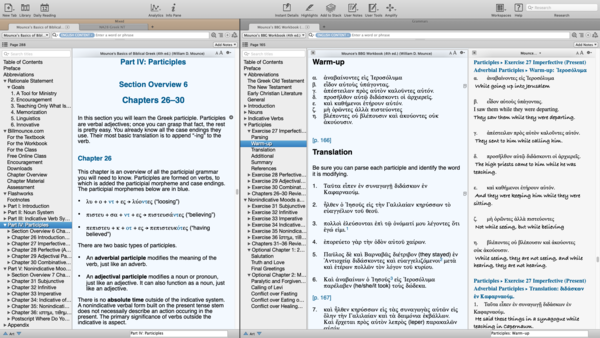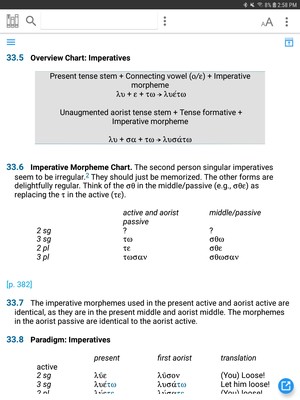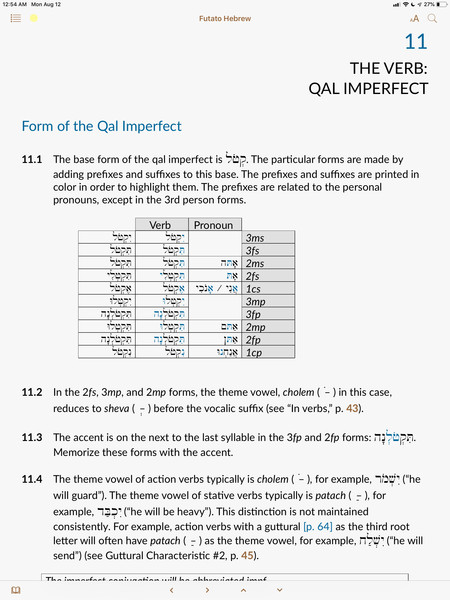Fall semester is upon us, and scores of students at Bible colleges and seminaries will begin (what will hopefully be) lifelong studies in biblical languages. This week, we are releasing an often-requested introductory Hebrew grammar for Accordance as well as a revision to a standard work for learning biblical Greek.
Accordance makes the perfect platform for learning biblical languages because of quick access to Hebrew and Greek texts as well as lexicons and grammar works. Instead of spreading out a half dozen physical books on a crowded desk, an Accordance user can organize specialized workspaces to accommodate each class. Every grammar comes with practice exercises. These can be worked in Accordance User Notes for later study or exported to turn in as homework assignments. For more ideas for using Accordance in biblical or theological studies, see our blog series, “Seven Strategies for Students Who Use Accordance.”
Click/tap on any of the images below for a larger view.
Mounce’s Basics of Biblical Greek (4th ed.) Grammar & Workbook
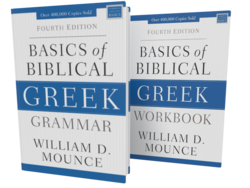
There are at least two kinds of Accordance users who will want to add BBG in the 4th edition to their personal Accordance Library. The first category is the student taking elementary Greek for the first time. These students probably don’t have any choice regarding selection of BBG over other grammars. Perhaps the Accordance edition of BBG is required for class, or perhaps the student wants to supplement a print copy with a digital version where more reliable notes and answers to exercises can be stored than with print copies.
The second category of Accordance users who will want to add the 4th edition of BBG are those who have benefitted from previous editions. The primary question these users will ask is How is the 4th edition different? There is a full list of differences available at Bill Mounce’s website. Some of these differences relate to issues specific to the print copy, so I’ve taken the liberty of condensing the list, only giving attention to differences users will see between the 3rd and 4th Accordance editions of BBG:
The layout is cleaner, which makes the content less intimidating, and the Professor has been moved to the website.
- Vocabulary is the same (except ἅγιος is moved forward to chapter 9). However, pay close attention to the semicolons in the vocabulary listings. They identify the different glosses for a word.
- A few exercise sentences have been replaced, and the order of the parsing exercises have been re-ordered in later chapters so that they go from easier to harder. Eventually, there will be a listing of those changes.
- Scholarship’s new understanding of the middle voice has been included, and teachers are invited to decide which approach to use. The same goes for the debate over σα and θη forms. QC codes will point you to YouTube presentations on some of these issues.
- Aspectual language is now used throughout. So the book talks about the imperfective aspect, imperfect tense, perfective aspect, aorist tense, combinative aspect, and the perfect tense. I always include the words “aspect” and “tense” to avoid confusion.
- Roots have been emphasized from chapter 4 on, are listed prominently in the vocabulary sessions, so when the student comes to chapter 20 it is natural and easy to think in terms of roots and stems.
And, of course, we can’t help pointing out that Dr. Mounce is an Accordance user himself. In the preface of BBG, he writes, “Much of the work, especially in the exercises, could not have been done without the aid of the software program Accordance. Thanks Roy and Helen.”
For a limited time, Accordance users may purchase both the grammar and workbook for Basics of Biblical Greek at introductory discounted pricing.
Basics of Biblical Greek Grammar
Regular Price $59.90
Basics of Biblical Greek Workbook
Regular Price $19.99
Futato’s Beginning Biblical Hebrew
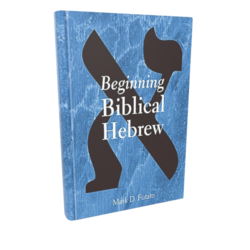
As stated in the introduction, BBH has been designed to provide “students with a thorough introduction to Biblical Hebrew in an easy-to-learn format.” Content does not assume any familiarity with Hebrew or even English grammatical terminology. Students will learn around 400 Hebrew words giving them a foundation for reading the Hebrew Bible.
40 chapters comprise BBH with each chapter broken into sections for grammar, vocabulary, and practice. Practice sections cover both new material as well as reviewing previous content. The back of the grammar contains a Hebrew-to-English vocabulary list, an answer key, and morphology charts for the verb.
If you have the Theological Journal Library in Accordance, you can read Andrew J. Schmutzer’s review of Beginning Biblical Hebrew in the December 2004 issue of The Journal of the Evangelical Theological Society. For a limited time Accordance users can purchase Futato’s Hebrew grammar at introductory discounted pricing.
Beginning Biblical Hebrew
Regular Price $49.90
Sale Price $49.90


